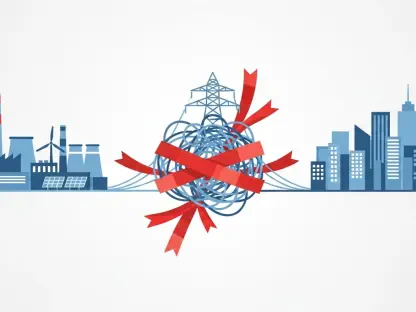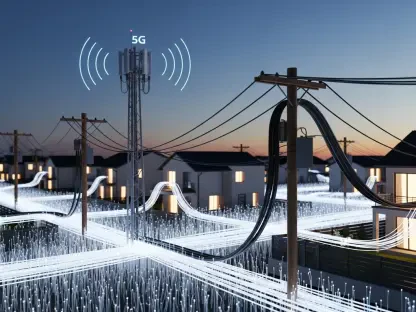Imagine a world where cities operate with seamless intelligence, vehicles navigate autonomously with split-second precision, and industries achieve unprecedented efficiency through real-time data—all powered by the invisible backbone of 5G technology. At the heart of this transformation lies the 5G Radio Access Network (RAN) Equipment Market, a vital segment of telecommunications infrastructure that is driving the next era of connectivity. This market is not just about faster internet; it’s about enabling a future where latency is virtually nonexistent, data capacity meets soaring demands, and energy efficiency aligns with global sustainability goals. As connected devices multiply and data consumption reaches new heights, the importance of robust RAN equipment becomes undeniable. This article explores the projected growth of this dynamic market, expected to reach a staggering $50 billion valuation by 2035 with a compound annual growth rate (CAGR) of 21.2%. From technological innovations to regional trends, the journey of 5G RAN equipment promises to reshape global communication landscapes.
Surging Demand and Market Expansion
The 5G RAN Equipment Market is poised for remarkable growth, fueled by an unrelenting surge in data usage and the proliferation of connected devices across consumer and industrial sectors. Forecasts indicate that this market will climb to an impressive $50 billion by 2035, achieving a robust CAGR of 21.2% from 2025 onward. This expansion is driven by the critical need for high-speed, reliable networks that can support transformative technologies such as the Internet of Things (IoT), autonomous vehicles, and smart urban infrastructure. Telecom operators are increasingly investing in advanced RAN solutions to meet these demands, recognizing that traditional network architectures often fall short in scalability and flexibility. The urgency to upgrade infrastructure is evident as industries and governments alike prioritize digital transformation, positioning 5G RAN equipment as a cornerstone of modern connectivity that can handle the complexities of tomorrow’s digital ecosystem with ease.
Another significant factor propelling this market forward is the adoption of private 5G networks, particularly in sectors like manufacturing, logistics, and healthcare. These tailored networks provide customized connectivity solutions that enhance operational efficiency and enable innovative applications, such as real-time monitoring and automation. The push for private networks reflects a broader trend of personalization in telecommunications, where specific industry needs drive infrastructure investments. Additionally, the global rollout of 5G services by major carriers continues to accelerate, creating a ripple effect that boosts demand for RAN equipment. As countries race to establish 5G dominance, the market benefits from both public and private sector commitments, ensuring sustained growth over the coming decade. This convergence of necessity and innovation underscores the market’s trajectory toward becoming a $50 billion powerhouse by 2035.
Innovations Driving Network Evolution
Technological advancements are at the core of the 5G RAN Equipment Market’s rapid evolution, with cutting-edge components and systems redefining network capabilities. Key elements such as baseband units, remote radio heads, and advanced antennas form the foundation of both centralized and distributed network models, enabling operators to adapt to varying deployment scenarios. Breakthroughs like massive MIMO (Multiple Input Multiple Output) technology stand out, allowing simultaneous handling of multiple data streams to significantly enhance network capacity. Similarly, dynamic spectrum sharing optimizes the use of existing frequency bands, ensuring efficient resource allocation. These innovations collectively address the growing need for high-throughput, low-latency networks that can support diverse applications, from streaming high-definition content to powering critical industrial processes, marking a new era in telecommunications performance.
Equally transformative is the integration of artificial intelligence (AI) and cloud-based solutions into RAN equipment, which are reshaping how networks are managed and optimized. AI tools enable predictive maintenance, traffic optimization, and real-time resource allocation, ensuring reliability even under heavy load conditions. Cloud orchestration further enhances flexibility by supporting network slicing, a technique that allows operators to create virtualized network segments tailored to specific use cases, such as ultra-low latency for autonomous systems or high bandwidth for multimedia services. Beyond performance, sustainability is gaining focus, with manufacturers adopting materials like gallium nitride (GaN) to develop energy-efficient designs that reduce power consumption without compromising output. These combined advancements position 5G RAN equipment as an indispensable enabler of global connectivity, ready to meet the escalating demands of a hyper-connected world.
Regional Dynamics and Adoption Trends
Geographically, the 5G RAN Equipment Market reveals diverse patterns of growth and adoption, shaped by differences in infrastructure investment, regulatory frameworks, and technological maturity. Asia-Pacific stands as the dominant force, propelled by substantial investments in 5G infrastructure and early adoption in nations like China, South Korea, and Japan. This region benefits from a vast consumer base and strong governmental backing for digital initiatives, which prioritize high-speed connectivity as a driver of economic progress. The scale of deployment in Asia-Pacific not only fuels market expansion but also sets benchmarks for global 5G standards, influencing how other regions approach their rollouts. As a result, this area remains a critical hub for RAN equipment demand, reflecting the intersection of population density, technological ambition, and policy support.
Meanwhile, North America is carving out a leadership role in enterprise-driven 5G RAN deployments, with a particular emphasis on private networks for industries such as manufacturing and logistics. The focus here is on innovation, with companies leveraging tailored connectivity to gain competitive advantages through enhanced automation and data analytics. Europe, on the other hand, is prioritizing secure and software-driven 5G implementations, placing a premium on data privacy and compliance with stringent regulations. European operators often adopt software-defined architectures to ensure flexibility and security in their networks. In contrast, developing regions in Africa and Latin America are exploring cost-effective models like shared spectrum to extend 5G coverage, especially in rural areas. These varied approaches highlight the adaptability of 5G RAN solutions to different economic and geographic contexts, ensuring that the benefits of next-generation connectivity reach a global audience.
Competitive Forces and Industry Shifts
The competitive landscape of the 5G RAN Equipment Market is vibrant, marked by the presence of industry giants and a growing cadre of innovative newcomers. Leading companies are driving progress through advancements in hardware, software, and integrated solutions, continuously pushing the boundaries of what 5G networks can achieve. Their dominance is challenged by the rise of Open RAN, a paradigm that fosters interoperability and allows smaller vendors to compete by offering specialized components and services. This shift is dismantling traditional vendor lock-ins, reducing costs, and accelerating deployment timelines for network operators. The resulting ecosystem is more collaborative, with partnerships and trials shaping the future of RAN technology, ensuring that innovation remains a shared endeavor rather than the domain of a select few.
Recent industry developments point to a strong focus on automation and sustainability as competitive differentiators. Manufacturers are rolling out AI-powered solutions that enable self-optimizing networks, minimizing manual oversight while maximizing efficiency. Cloud-based tools are also gaining traction, facilitating network slicing to cater to specific application needs, from low-latency requirements to high-bandwidth demands. Additionally, sustainability efforts are becoming central, with energy-efficient designs addressing environmental concerns and aligning with global regulatory expectations. Open RAN initiatives, backed by major operators, are further standardizing interoperable solutions, ensuring that flexibility and inclusivity define the market’s evolution. This dynamic interplay of competition and collaboration is setting the stage for a more resilient and innovative 5G RAN equipment sector.
Future Horizons and Strategic Insights
Looking toward the future, the 5G RAN Equipment Market is expected to evolve in tandem with broader telecommunications trends, particularly the shift to 5G Advanced and beyond. Emerging networks will likely incorporate deeper AI-driven self-optimization, extensive virtualization, and hybrid cloud capabilities, creating systems that are not only scalable but also fully automated. The fusion of Open RAN with AI orchestration stands to redefine telecom architecture, allowing operators to manage increasingly complex networks with remarkable precision. Such advancements will be crucial as data demands continue to escalate, requiring infrastructure that can adapt dynamically to fluctuating needs while maintaining high performance across diverse applications and environments.
Sustainability will also play a pivotal role in shaping the market’s trajectory, as energy-efficient designs become a non-negotiable priority for manufacturers and operators alike. With growing global emphasis on environmental responsibility, adopting green technologies in RAN equipment will be essential to comply with regulations and meet corporate sustainability targets. Furthermore, the expansion of private 5G networks in industrial sectors is anticipated to drive demand for customized solutions, diversifying the market’s offerings. As these trends unfold through 2035, stakeholders must focus on fostering innovation, embracing open standards, and prioritizing eco-friendly practices to ensure that the benefits of 5G connectivity are both widespread and sustainable, paving the way for a digitally empowered future.









